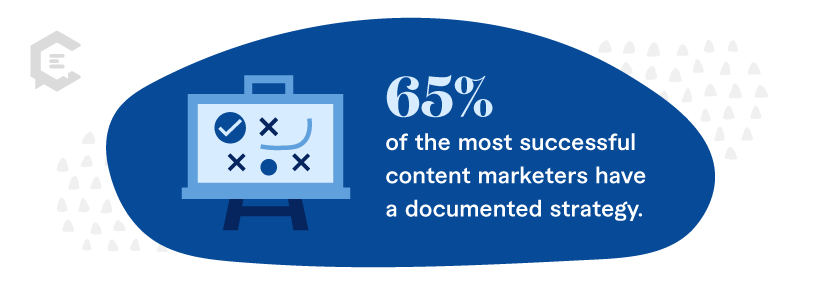Despite the rise of video, the blog is still a cornerstone of any solid content marketing strategy.
- Marketers who prioritize blogging are 13x more likely to see a positive ROI. [HubSpot]
- Websites that have a blog attract 55 percent more traffic than ones that don’t. [QuickSport]
- Businesses that blog get 97 percent more links to their website [OptinMonster]
But, what does it take to create and manage a successful blog now and looking toward the future?
In this article, we’ll dive into the key factors that define the best blogs and how you can emulate their success.
5 Key Factors in the Best Blogs
1. Documented strategy
According to the Content Marketing Institute’s annual research, 65 percent of the most successful content marketers have a documented strategy. That’s vs. 14 percent of the least successful.
It’s essential to know where you’re going. Determine your specific blogging goals, write them all down, and ensure they align with your overall content strategy. If you need help identifying goals, start by studying the blogs you admire.
Make a list of a half-dozen sites. They can be from within your industry or just sites that create eye-catching content that grabs your attention. What characteristics make these blogs stand out? Here are a few to consider paying attention to:
- Length
- Type of content
- Number of shares and comments
- How they promote it
Pull all your findings into a single document to start building your specific strategy. You can use our Content Strategy Essentials Checklist to get started.
2. Empathy
The most successful blogs create content that evokes strong emotions and inspires action.
To craft empathetic blog content, focus on better understanding:
- Your readers’ interests
- Pain points
- Motivating factors
In other words, get inside their minds. How to do that? Audience research.
Go through the process of creating buyer personas. It can be one of the most fun parts of your blog strategy. Have conversations with past and current customers as well as potential prospects. Start with a Q&A about their current job, what industry they’re in, some personal background, and what influences them. Then ask yourself three questions:
- Why do they need or want your product?
- What can you do to better serve them?
- What have you been getting wrong so far?
3. Visual content
As you’re crafting your blogs, never underestimate the power of visual content.
Articles with visuals get 94 percent more views and up to 40x more social shares than articles without.
As you write your blog, brainstorm ways that visual content can enhance your story. For example, if you’re managing a software and tech blog with complex technical jargon, consider supporting your writing with an explainer video or infographic to make your content more digestible.
And, your visual content doesn’t necessarily need to be expensive. Outsourcing your visual content creation to an expert videographer or graphic designer can ensure visual consistency while saving time and resources.
4. Natural, relevant links
Linking is essential to creating a healthy digital ecosystem for your content.
Your blogs should link to authoritative, trustworthy sites that improve the user’s experience.
Here’s a good rule of thumb: For every 300 words of copy, provide one link to a resource that either supports your own claims or helps readers research further.
While it may seem counterintuitive to send your hard-earned traffic off-site, readers care more about finding content that matches their needs and less about who created it. In the end, they’ll thank you for guiding them to the best content and will come back to you as a resource in the future.
Plus, linking is a great opportunity to give credit to other content creators and open doors for possible co-marketing opportunities in the future.
5. Audience engagement
The average consumer’s attention span is eight seconds. That is…not a lot of time. That’s less time than it takes to tie a shoelace or brew a cup of coffee.
That means your blog content needs to resonate immediately to hold readers’ attention. True audience engagement goes deeper. It’s about creating content that speaks directly to the readers’ needs, interests, and emotions. And about prompting them not only to stay but also to interact and return for more.
But audience engagement can be a time-consuming process, especially because it’s not easy to automate. It requires nuanced human oversight.
Consider investing in expertise. Hiring expert writers, or even social media content creators, who excel at quickly connecting with audiences can be a game changer.
Bonus: Impeccable grammar
Blogs are written content. Good grammar is non-negotiable. A small slip-up here and there won’t kill you. However, having a high editorial quality for all your writing is essential to solidifying a great reputation for your brand.
Next Steps in Your Blog Journey
Applying these five key factors will get you started down the road of writing high-quality blogs. And if you want to take your content creation even further, ClearVoice is here to help. Our expert writers can help you craft compelling blogs that increase engagement and drive conversion. Talk to a specialist today to get started.






